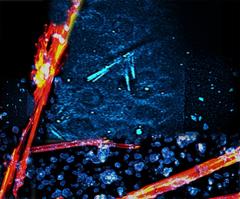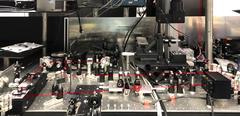URL: https://www.desy.de/news/news_search/index_eng.html
Breadcrumb Navigation
DESY News: Supermicroscope for Protein Crystals
News
News from the DESY research centre
Supermicroscope for Protein Crystals
A novel kind of microscope is able to detect tiny protein crystals, which are beyond the imaging power of even modern light microscopes. The innovative technique relies on various non-linear optical effects to image even nanocrystals, which are increasingly being used for protein structure analyses nowadays. The team that developed this method, headed by DESY’s Franz Kärtner, Christian Betzel from the University of Hamburg and Guoqing Chang from the Chinese Academy of Sciences, is presenting its “multimodal multiphoton microscope” in the journal Communications Biology.

The brighter and more tightly focused the X-rays, the smaller the crystals for structural analysis can be. This is a major advantage, because many proteins are very difficult to grow as crystals, since this is not a state that is meant to occur in their natural environment. In many cases, only tiny crystals of such proteins can be grown. “As X-ray sources are becoming better and better, there is an increasing demand for micro- and nanocrystals,” explains Betzel who, like Kärtner, is also a member of the Hamburg Centre for Ultrafast Imaging, CUI.
The problem facing the researchers is that they first have to find these tiny crystals in the suspension. The protein crystals are not only small, however; they are usually transparent and not unlike salt crystals. “For years, we have been coming up against the limits of our ability to detect these minute crystals, even using ultramodern microscopes,” explains Kärtner, who works at the Centre for Free-Electron Laser Science, CFEL, which is jointly operated by DESY, the University of Hamburg and the Max Planck Society. “These mostly colourless protein crystals are extremely difficult to locate in aqueous solutions when we are preparing to take measurements, and they are often overlooked altogether,” adds Qing-di Cheng, one of the lead authors and PhD student at University Hamburg.

Setup of the multimodal multiphoton microscope in the laboratory with laser beam paths drawn in: The laser source is located in the centre of the image. The beam is then split and converted into two different wavelengths, which are finally reunited and directed through the vertical tube onto the sample. Credit: DESY
The new multiphoton microscope uses a specially designed multicolour fibre laser that generates intense ultrashort laser pulses in the infrared range lasting just one tenth of a trillionth of a second (tenth of a picosecond). These pulses initially have a wavelength of 1550 nanometres. By doubling the frequency, the system generates laser pulses with half that wavelength, 775 nanometres, which lies just beyond the visible spectrum in the near infrared. At the same time, the system also produces laser pulses with a wavelength of 1300 nanometres through non-linear wavelength conversion. The sample is illuminated by both these pulses.
“The multiphoton microscope driven by this type of a fibre-based ultrafast light source provides a robust and cost-effective means of detecting protein crystals using frequency doubling, frequency tripling, and three-photon fluorescence,” says Hsiang-Yu Chung, a postdoctoral fellow at CFEL and the other lead author of the publication.

PAK4 protein crystals grown in biological cells, just visible under the optical microscope (left), in the light of second (SHG, centre) and third harmonics (THG, right) confirm the function of the method. Credit: Cheng, Q., Chung, H., Schubert, R. et al., Commun Biol, Linkhttps://doi.org/10.1038/s42003-020-01275-8
The shorter wavelength is also chosen such that it can trigger fluorescence in the amino acid tryptophane, which occurs in proteins. To do so, electrons in this amino acid need to absorb three photons (light particles) at once from the laser pulse. This is possible if the density of the laser photons is high enough. For this to be the case, the laser must be tightly focused. The multiple absorptions which are of interest and which give multiphoton microscopes their name, can only take place at the focal point. With the new protein microscope, the resulting fluorescence lies in the UV range, whereas the laser beam used is in the infrared range. This makes it easy to separate the light produced from the incoming light, so that the radiation coming from the protein crystals can be reliably detected.
The technique has been put to the test in the laboratory using suspensions containing various microcrystals. Tiny crystals of the proteins lysozyme, thaumatin, thermolysin and PAK4 were reliably detected. “Commercially available microscopes for such applications are limited in their performance; in particular, they are much less sensitive and cannot reliably distinguish between protein crystals and salt crystals,” says Chang. “The MPM system described by us is likely to attract a great deal of interest within the structural biology community, especially in laboratories working at X-ray sources, but also at institutions and laboratories working in neurobiology, for example.”
The research was supported by the Cluster of Excellence “Advanced Imaging of Matter” of the German Research Foundation (DFG) – EXC 2056 – Project ID 390715994, the Helmholtz Excellence Network “Structure, Dynamics and Control on the Atomic Scale”, the Helmholtz Young Investigator Group (VH-NG-804), the Helmholtz-CAS Joint Research Group (HCJRG 201), the DFG project BE1443/29-1, as well as by the German Aerospace Centre (DLR) and the BMBF via the projects 50WB1422,05K16GUA. The Joachim-Herz Stiftung Hamburg also supported this research via the Infecto-Physics project.
Reference:
Protein-crystal detection with a compact multimodal multiphoton microscope; Qing-di Cheng, Hsiang-Yu Chung, Robin Schubert, Shih-Hsuan Chia, Sven Falke, Celestin Nzanzu Mudogo, Franz X. Kärtner, Guoqing Chang & Christian Betzel; Communications Biology, 2020; DOI: 10.1038/s42003-020-01275-8



